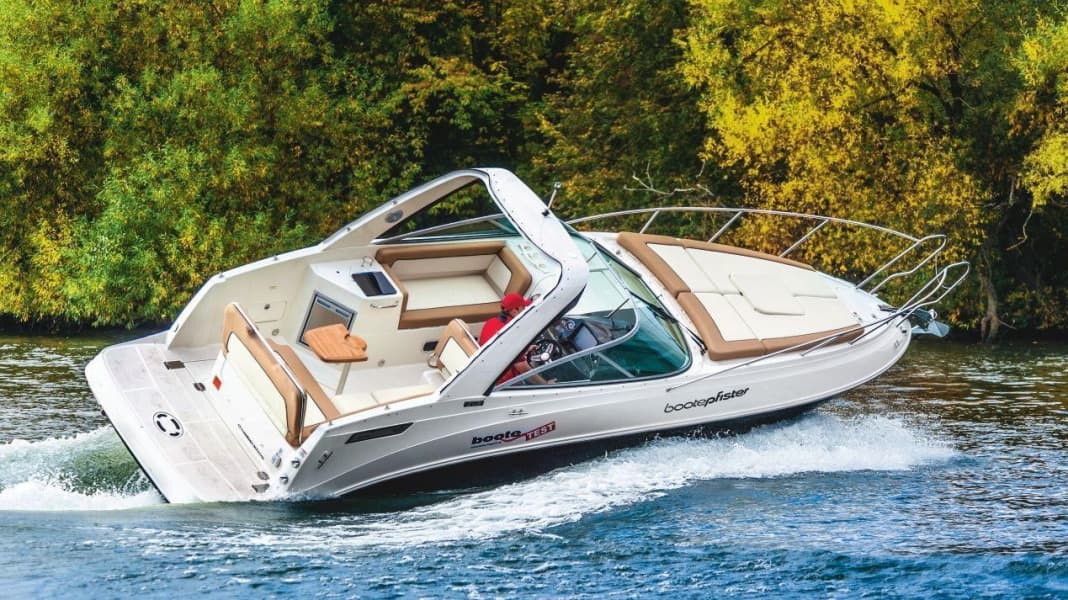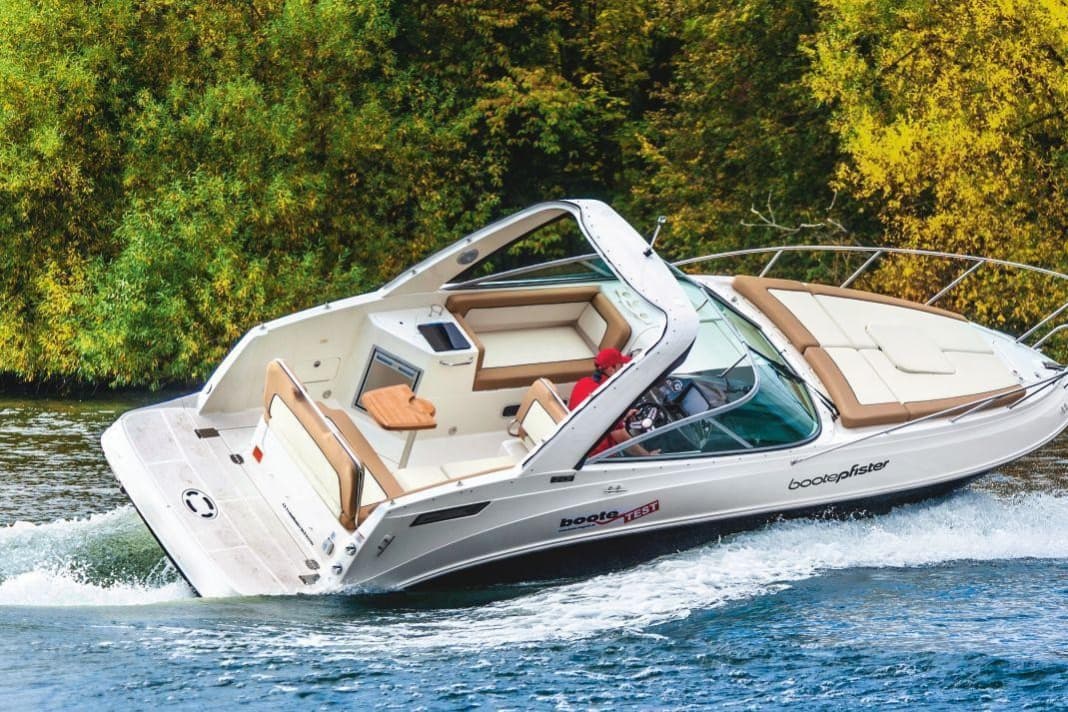
The American brand Bayliner is not onlya household name on the German market and has experienced many ups and downs. There were times when quality was not up to expectations. That was a long time ago and has been over at least since the boats were built in Poland.
"Made in Poland" has even changed the image for the better, and our test boat is no exception.
The good marks for workmanship, electrical and technical installations and equipment are more than justified. Howeverthe weight speaks against easy mobility on land, because a trailer with a load capacity of at least three tonnes is required for transport.
Driving and manoeuvring
Whether travelling forwards or backwards, the test boat moves where it should at slow speed. Full circles measure a maximum of 1 ½ boat lengths, and if it takes a little too long when reversing with a gear engaged, the bow thruster (extra) is used.It's called manoeuvrable. Up to a speed of around 5 knots, people changing places in the boat have little influence on the course and heeling, which is why it is better to sail the slow passages half a knot faster. The waves generated by the boat also remain acceptable.
From 3000 rpm or 14 knots, the bow lowers and the test boat begins to glide with the drive fully trimmed and without supporting trim tabs.
We measure the maximum speed with an almost empty boat at 34 knots, with the engine turning at no more than 5100 rpm. After analysing our measurement data, we determine theEconomic gliding at 3500 rpm or a speed of 21 knots. One tank of fuel is enough for a theoretical range of 128 nm plus 15% reserve.But that is not enough for us. Those in a hurry have to look around for a bunker station after about 91 nm at full speed.






You can only go further at displacement speed, as just under 200 nm are possible at 5 knots. The noise limit of 85 dB/A is only exceeded at full throttle.
Our test area is the Main near Schweinfurt, narrow in places and no rough water.
We can therefore say little about the latter, except that we can safely and comfortably negotiate commercial shipping waves without any great difficulty. The boat runs as if on rails, so to speak, which is due to the hull design with its longitudinal planing steps.
The planing steps usually end in the keel area, in the rear third of the boat's hull. On the 842 CU, they are extended all the way aft. Although this provides speed because the boat lifts a little more out of the water, it also means that the planing steps grip too much, as with the extreme manoeuvres performed at almost full speed in tight and fast bends.
You could also say that they hook in. And that's what the test boat does during the 180° turns as long as we keep the power trim in the drive position (½ on the display). Then the 180° turns are accompanied by proper rocking movements and violent settling manoeuvres. This means considerable centrifugal forces (up to 1.8 g), which require a good grip and handholds, of which one would wish for a little more.
The situation is completely different with trim down or with the Z-drive fully trimmed to the mirror. In this case, the centrifugal forces are moderate and the boat goes round in one go without rocking or hooking. On the imaginary slalom course, the continuous planing steps plus the deep V-hull are responsible for our test boat tipping over the longitudinal axis safely, but with a "sweeping hip swing".
During normal cornering, everything is in the green zone, whether the drive is optimised or fully trimmed. Then the 842 CU leans towards the centre of the curve and follows its course cleanly. At best, you can hear the twin propellers gasping for air at the narrowest point. This disappears as soon as you either steer out of the turn or trim the drive to the "down" position.
The driver sits on a longitudinally adjustable bench seat, the seat cushion of which can be partially folded up - elevated seating or just leaning back.
You have an unrestricted view of all the instruments and the controls are within easy reach.
With the exception of reflective instruments and light-coloured surfaces, the slightly tinted windscreen does not impair visibility. In the rain, however, the wiper only creates a peephole. The servo control is child's play to turn, while the electronic single-lever gearstick sends the impulses to the gearbox and motor without complaint.
Passengers sit opposite on a bench seat installed lengthways, on which they only have a hold when the cabin door is closed, and at the rear they hold on to the handle on the galley.
Engine, tank, electrics
The engine compartment flap is raised and lowered electrically together with the rear cockpit bench seat and plug-in table mounted on it. Once open, everything is clearly laid out and easily accessible for inspection and servicing. The technical and electrical installations give no cause for criticism.
This applies to the missing fuel shut-off valve; the non-return valve in the fuel line does not count as such. When cleaning the petrol, you rely solely on the engine manufacturer. The batteries are well protected in plastic trays and the corresponding main switch and fuses are located under a flap behind the galley in the cockpit.
Security
This is where the 842 CU scores with its good handling characteristics, as long as the rudder is not moved frantically at high speed. A sample taken of the sound insulation passes the fire test, and the automatic fire extinguisher in the engine compartment can also be triggered remotely.
Water in the engine compartment can be drained either manually or electrically. Water in the cockpit flows outboard.Positive: The cockpit interior height is correct.NegativeThere is no closure in the aft passageway. However, the shipyard wants to retrofit a door here.
Living, cockpit and equipment
The living area is standard in the Cuddy class with a seating area that can be converted into a V-berth with a table in the foredeck and an underfloor cabin below the cockpit. There is enough space for four people, who have to sleep close together.
Otherwise you can manage. The separate toilet room, which is ventilated via a porthole, only has a moderate amount of space, which is due to the design. In the cockpit there is a galley with cooker, refrigerator and an ice box under the longitudinal bench seat opposite.
You can sunbathe either on the rear bench or on the bow. There is only one thing to criticise about the upholstery at the front, because the weight and size mean that you always leave it lying around. The navigation lighting does not meet our requirements as it is not approved for the whole of Germany. The canopy and tarpaulin cost extra, as do other accessories for comfort.
Our conclusion
This Bayliner can be seen in the upper class. The handling characteristics are good as long as you don't turn the helm frantically at high speed. The amount of space is due to the typical layout of a day cruiser, but it fits so far. She is a fine all-rounder on which the crew can sometimes stay longer if the appropriate equipment is ticked on the accessories list.
Data sheet: Bayliner 842 Cuddy
Shipyard: Bayliner
Type designation: Bayliner 842 Cuddy
CE category: C - Coastal waters
Material of hull and deck: Plastic
Length: 8,88 m
Width: 2,55 m
Displacement: 3,00 t
Price: 87.169,00 €


